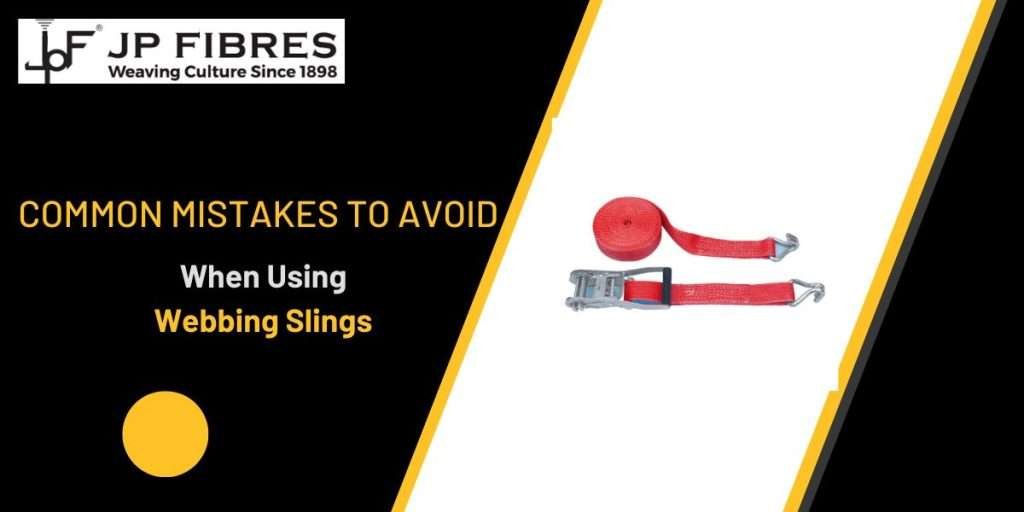Webbing slings are essential tools in lifting and rigging operations, known for their flexibility, lightweight design, and high load-bearing capacity. However, improper usage can lead to accidents, injuries, or damage to materials. To ensure safety and efficiency, it is crucial to avoid common mistakes when using webbing slings.
1. Overloading the Webbing Sling
One of the most frequent errors is exceeding the webbing sling’s rated capacity, often due to improper load estimation or neglecting the manufacturer’s specifications. Overloading can cause the sling to fail, leading to dropped loads and potential injuries.
How to Avoid It
Check the Load Capacity: Always refer to the manufacturer’s label or documentation for the sling’s working load limit (WLL).
•Assess the Load Weight: Use accurate equipment to determine the weight of the load.
•Factor in the Configuration: Remember that the sling’s capacity changes depending on the lifting method (e.g., straight, choked, or basket lift).
2. Ignoring Sling Inspections
Failing to inspect webbing slings regularly is another common oversight. Worn-out, damaged, or contaminated slings can weaken significantly and increase the risk of failure.
How to Avoid It
Inspect Before Each Use: Look for visible damage, such as cuts, abrasions, fraying, or chemical burns.
•Follow Maintenance Schedules: Conduct periodic detailed inspections as recommended by the manufacturer.
•Replace Damaged Slings: Never use a sling that shows signs of wear or damage. Always err on the side of caution.
3. Using Webbing Slings in Improper Environments
Exposing webbing slings to harsh conditions such as extreme temperatures, sharp edges, or chemicals can compromise their integrity. For instance, polyester slings are vulnerable to strong acids, while nylon slings can degrade in alkaline environments.
How to Avoid It
•Understand Material Limitations: Choose slings made from materials suitable for the environment they’ll be used in.
•mUse Edge Protectors: Protect slings from sharp edges using padding or protective sleeves.
•Avoid Prolonged Exposure: Minimize contact with extreme temperatures, UV rays, or corrosive substances.
4. Improper Sling Configuration
Incorrectly arranging the sling during lifting operations, such as using a single sling for an unbalanced load or improper hitching, can cause instability and failure.
How to Avoid It
Use the Right Hitch: Choose a hitch method (vertical, choker, or basket) that suits the load and lifting requirements.
•Balance the Load: Ensure the load is evenly distributed to prevent shifting during lifting.
•Follow Manufacturer Guidelines: Adhere to specific instructions for sling configuration and use.
5. Knots and Twists in the Sling
Knots, twists, or kinks in a webbing sling reduce its strength and can cause it to fail under tension. Improper storage often leads to these issues.
How to Avoid It
•Store Properly: Hang slings on racks in a clean, dry environment, away from sharp objects or heavy equipment.
•Check for Twists: Before use, lay the sling flat and straighten out any twists or kinks.
•Avoid Knots: Never tie knots in the sling to shorten its length or secure the load.
6. Failing to Train Operators
Untrained personnel operating webbing slings may lack the knowledge to use them safely, increasing the likelihood of mistakes and accidents.
How to Avoid It
•Provide Comprehensive Training: Ensure all operators are trained in sling selection, inspection, and usage.
•Highlight Safety Standards: Familiarize workers with industry standards such as OSHA or ASME guidelines.
•Encourage Continuous Learning: Offer refresher courses to keep skills and knowledge up to date.
7. Misusing the Sling for Non-Lifting Tasks
Using webbing slings for unintended purposes, such as towing vehicles or dragging heavy objects, can lead to wear and tear, reducing their effectiveness for lifting.
How to Avoid It
•Stick to Intended Use: Use slings strictly for lifting operations as specified by the manufacturer.
•Invest in Appropriate Tools: For non-lifting tasks, use tools specifically designed for those purposes.
8. Neglecting to Secure Loads Properly
Improperly securing the load to the sling can cause the load to slip, tilt, or fall, creating a significant safety hazard.
How to Avoid It
•Double-Check Attachments: Ensure the load is securely attached and balanced before lifting.
•Use Additional Support: Employ load binders or straps if necessary to stabilize the load.
•Test Before Lifting: Perform a trial lift to confirm the load is secure and stable.
9. Not Considering Sling Stretch
Ignoring the potential stretch of a webbing sling under load can lead to misjudgment of lifting heights or reduced control over the load.
How to Avoid It
•Account for Stretch: Factor in the elasticity of the sling material during planning.
•Use Low-Stretch Slings: For applications requiring minimal stretch, opt for polyester over nylon slings.

